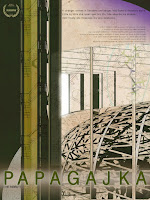The
apartment complex where Damir lives and works probably looked great as a scale
model, but the hulking brutalist building does not exactly have a homey feel.
There hardly seems to be any people living there, but it is probably just as
well. He isn’t much of a night watchman. His life is about as modest as it
gets, yet a mystery woman will try to take control of it anyway in Emma
Rozanski’s Papagajka (trailer here), which screens at
the 2016 SXSW.
The
building definitely stands out, but Damir prefers to go through life unnoticed.
He only interacts with a handful of residents, including the party girl,
Kamala, whose interest confuses him. One day, Tasya starts wandering through
the complex’s once grand external staircases, lugging a suitcase behind her. Approaching
Damir, she claims to be a tourist, whose purse and passport were stolen.
Somehow, Damir agrees to let her stay in his flat until she can sort herself
out. Clearly self-assertion is a problem for him, but saying no to Tasya will
be particularly difficult.
Soon
Tasya drops all pretenses of leaving. She shrugs off questions about her friend
and starts clearing out Damir’s possessions. She even starts to have an ominous
effect on his dreams. With both his mental and physical health suffering, Damir
loses the strength to fight Tasya’s dominating control games.
Rozanski
studied under Bela Tarr at his Sarajevo based film.factory and it is not hard
to discern his influence on the debut filmmaker—so viewers should consider
themselves warned. Indeed, this is exactly the sort of story that works better
with more genre trappings. The locale is wildly sinister, but the pace is art
house extreme, all the way.
Still,
for those willing to cowboy-up for some slow cinema, Rozanski’s control of mood
and atmosphere are quite impressive. Adnan Omerovic (resembling Iggy Pop’s malnourished
grandson) is deceptively quiet and reserved, expressing volumes with hardly any
words. Susanna Cappellaro is also keeps the audience consistently off-balance.
There is something hard to describe but eerily disconcerting about her
presence.
Aside
from the recognizable building itself, there is little about the film that readily
identifiably Bosnian per se. It is tempting to read into the Bartleby’s
character’s existential annihilation some sort of analogy for the atrocities of
the Balkan Wars. However, it is healthier to see the film as a sign Bosnian
artists are ready to process other topics and sources of inspiration. Recommended
for a narrow strata of cineastes, the aesthetically demanding Papagajka screens again tonight (3/14)
and this Thursday (3/17), as part of this year’s SXSW.

